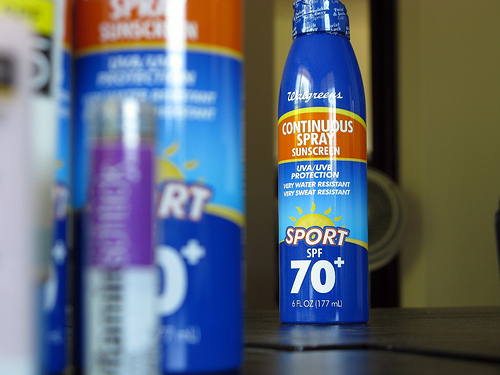By Taylor Johnson (The Cascade) – Email
Print Edition: July 18, 2012
After what seemed like an eternity of rain I took off to the Arizona Desert for some much needed sunshine. One-hundred-and-nine-degrees Fahrenheit of pure sunshine to be exact. That’s hotter than most people’s hot tubs! In my luggage was an arsenal of sun-ray fighting sunscreens: SPF 15, SPF 30 and SPF 60. Protection from damaging ultraviolet-B (UV-B), cancer causing ultraviolet-A (UV-A) and ultraviolet-Radiation (UV-R) rays produced by the sun.
Most sunscreens are made up of Alcohol Denat, Acrylates/Octylacrylamide, Oxybenzone, Copolymer and scented lotions. However not all sunscreens contain the important, zinc oxide and titanium dioxide which are vital in blocking out both UV-A and UV-B rays. These ingredients soak into skin, forming a barrier between skin cells and harmful sun rays. Over time these ingredients break down due to perspiration, fresh or salt water and direct sunlight. This is where the Sun Protection Factor (SPF) comes into account: the higher the SPF, the stronger the barrier against the elements. Ever noticed how SPF fifteen feels more like a watery hand lotion compared to the thick paste-like SPF sixty?
Using a stronger SPF does not necessarily mean that you bikini clad sun-lovers can lie out in the sun all day without fear of burns. It simply refers to the amount of rays that can be absorbed. The Skin Cancer Foundation estimates that anything lower than an SPF 15 will prevent burns, or a tan, but cannot block out dangerous UV-A UV-B or UV-R rays. Their website states that an SPF of 15 or higher can be considered typical for everyday use, where there is minimal direct sun exposure. An SPF of 30 blocks out 97 per cent of hazardous rays, while giving you that summer time glow, and SPF 50 blocks out an estimated 98 per cent.
To get the most out of your sunscreen—whatever the SPF—the SCF recommends that you evenly apply about two tablespoons for your entire body a half hour before being exposed to sunlight. This allows enough time for sunscreen to be absorbed into skin. While two tablespoons seems like quite a bit of sunscreen, sensitive areas like the face, hands and feet have thinner skin and require more sunscreen to form a thicker barrier. After the initial application, sunscreen should be reapplied every two hours you are in direct sunlight, or immediately after water exposure or heavy sweating.
For those who worry sunscreen will block out any possibility of a bronzed tan, consider the alternatives: fried chicken skin which creases and wrinkles no matter what your age is, painful skin blisters, or increased risk of skin cancers.
There are many alternatives to a sun-based tan: the SCF, Health Canada, and a variety of other cancer prevention sites recommend DHA (dihydroxyacetone): this is a skin cell darkening agent that, over time, dis-adheres to skin with no proven long-term effects. In short, it will give you a suntanned glow hopefully without damaging skin cells. DHA is available in a wide variety of self-tanners found anywhere from high-end boutiques to local drug stores, starting at $20 (NeoStrata’s Natural Insta-Tan, Shopper’s Drug Mart.
This summer, while you’re lying out on the deck wearing your favourite polka-dot bikini or sweating it out on the volleyball court, take that extra couple seconds to lather up! By winter that bronzed tan will fade but the damage left behind can last a lifetime.


